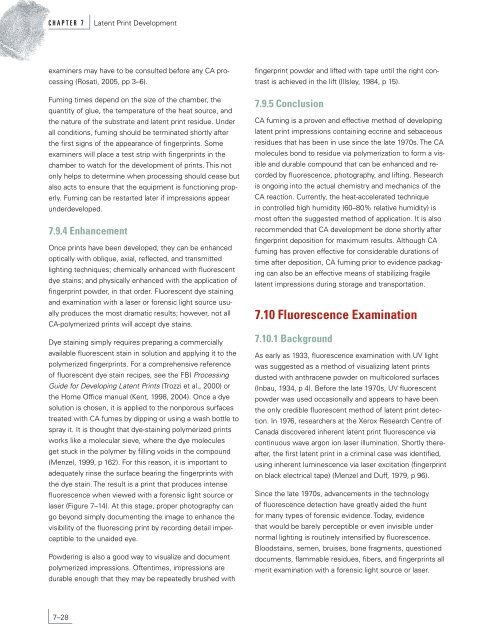Latent Print Development - National Criminal Justice Reference ...
Latent Print Development - National Criminal Justice Reference ...
Latent Print Development - National Criminal Justice Reference ...
You also want an ePaper? Increase the reach of your titles
YUMPU automatically turns print PDFs into web optimized ePapers that Google loves.
C H A P T E R 7 <strong>Latent</strong> <strong>Print</strong> <strong>Development</strong><br />
examiners may have to be consulted before any CA pro-<br />
cessing (Rosati, 2005, pp 3–6).<br />
Fuming times depend on the size of the chamber, the<br />
quantity of glue, the temperature of the heat source, and<br />
the nature of the substrate and latent print residue. Under<br />
all conditions, fuming should be terminated shortly after<br />
the first signs of the appearance of fingerprints. Some<br />
examiners will place a test strip with fingerprints in the<br />
chamber to watch for the development of prints. This not<br />
only helps to determine when processing should cease but<br />
also acts to ensure that the equipment is functioning prop-<br />
erly. Fuming can be restarted later if impressions appear<br />
underdeveloped.<br />
7.9.4 Enhancement<br />
Once prints have been developed, they can be enhanced<br />
optically with oblique, axial, reflected, and transmitted<br />
lighting techniques; chemically enhanced with fluorescent<br />
dye stains; and physically enhanced with the application of<br />
fingerprint powder, in that order. Fluorescent dye staining<br />
and examination with a laser or forensic light source usu-<br />
ally produces the most dramatic results; however, not all<br />
CA-polymerized prints will accept dye stains.<br />
Dye staining simply requires preparing a commercially<br />
available fluorescent stain in solution and applying it to the<br />
polymerized fingerprints. For a comprehensive reference<br />
of fluorescent dye stain recipes, see the FBI Processing<br />
Guide for Developing <strong>Latent</strong> <strong>Print</strong>s (Trozzi et al., 2000) or<br />
the Home Office manual (Kent, 1998, 2004). Once a dye<br />
solution is chosen, it is applied to the nonporous surfaces<br />
treated with CA fumes by dipping or using a wash bottle to<br />
spray it. It is thought that dye-staining polymerized prints<br />
works like a molecular sieve, where the dye molecules<br />
get stuck in the polymer by filling voids in the compound<br />
(Menzel, 1999, p 162). For this reason, it is important to<br />
adequately rinse the surface bearing the fingerprints with<br />
the dye stain. The result is a print that produces intense<br />
fluorescence when viewed with a forensic light source or<br />
laser (Figure 7–14). At this stage, proper photography can<br />
go beyond simply documenting the image to enhance the<br />
visibility of the fluorescing print by recording detail imper-<br />
ceptible to the unaided eye.<br />
Powdering is also a good way to visualize and document<br />
polymerized impressions. Oftentimes, impressions are<br />
durable enough that they may be repeatedly brushed with<br />
7–28<br />
fingerprint powder and lifted with tape until the right con-<br />
trast is achieved in the lift (Illsley, 1984, p 15).<br />
7.9.5 Conclusion<br />
CA fuming is a proven and effective method of developing<br />
latent print impressions containing eccrine and sebaceous<br />
residues that has been in use since the late 1970s. The CA<br />
molecules bond to residue via polymerization to form a vis-<br />
ible and durable compound that can be enhanced and re-<br />
corded by fluorescence, photography, and lifting. Research<br />
is ongoing into the actual chemistry and mechanics of the<br />
CA reaction. Currently, the heat-accelerated technique<br />
in controlled high humidity (60–80% relative humidity) is<br />
most often the suggested method of application. It is also<br />
recommended that CA development be done shortly after<br />
fingerprint deposition for maximum results. Although CA<br />
fuming has proven effective for considerable durations of<br />
time after deposition, CA fuming prior to evidence packag-<br />
ing can also be an effective means of stabilizing fragile<br />
latent impressions during storage and transportation.<br />
7.10 Fluorescence Examination<br />
7.10.1 Background<br />
As early as 1933, fluorescence examination with UV light<br />
was suggested as a method of visualizing latent prints<br />
dusted with anthracene powder on multicolored surfaces<br />
(Inbau, 1934, p 4). Before the late 1970s, UV fluorescent<br />
powder was used occasionally and appears to have been<br />
the only credible fluorescent method of latent print detec-<br />
tion. In 1976, researchers at the Xerox Research Centre of<br />
Canada discovered inherent latent print fluorescence via<br />
continuous wave argon ion laser illumination. Shortly there-<br />
after, the first latent print in a criminal case was identified,<br />
using inherent luminescence via laser excitation (fingerprint<br />
on black electrical tape) (Menzel and Duff, 1979, p 96).<br />
Since the late 1970s, advancements in the technology<br />
of fluorescence detection have greatly aided the hunt<br />
for many types of forensic evidence. Today, evidence<br />
that would be barely perceptible or even invisible under<br />
normal lighting is routinely intensified by fluorescence.<br />
Bloodstains, semen, bruises, bone fragments, questioned<br />
documents, flammable residues, fibers, and fingerprints all<br />
merit examination with a forensic light source or laser.

















